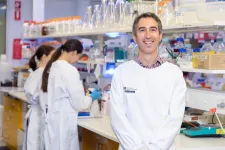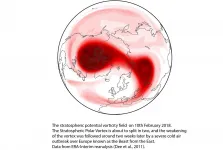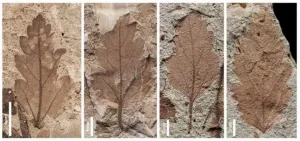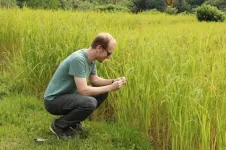Climate change caused mangrove collapse in Oman
Study points to sudden decrease of precipitation as cause
2021-01-05
(Press-News.org) Most of the mangrove forests on the coasts of Oman disappeared about 6,000 years ago. Until now, the reason for this was not entirely clear. A current study of the University of Bonn (Germany) now sheds light on this: It indicates that the collapse of coastal ecosystems was caused by climatic changes. In contrast, falling sea level or overuse by humans are not likely to be the reasons. The speed of the mangrove extinction was dramatic: Many of the stocks were irreversibly lost within a few decades. The results are published in the journal Quaternary Research.
Mangroves are trees that occupy a very special ecological niche: They grow in the so-called tidal range, meaning coastal areas that are under water at high tide and dry at low tide. Mangroves like a warm climate; most species do not tolerate sea surface temperatures below 24 °C (75°F). They are tolerant to salt, but only up to a tolerance limit that varies from species to species. "This is why we find them nowadays mostly in regions where enough rain falls to reduce salinization of the soil," explains Valeska Decker of the Institute for Geosciences at the University of Bonn, the lead author of the study.
Fossil finds prove that there used to be many mangrove lagoons on the coast of Oman. However, some 6,000 years ago these suddenly largely vanished - the reasons for this were previously disputed. Over the past few years, Decker traveled several times to the easternmost country of the Arabian Peninsula to pursue this question for her doctoral thesis. With the support of her doctoral supervisor Prof. Gösta Hoffmann, she compiled numerous geochemical, sedimentological and archaeological findings into an overall picture. "From our point of view, everything suggests that the collapse of these ecosystems has climatic reasons," she says.
Low pressure trough shifted to the south
Along the equator there is a low pressure trough, the Intertropical Convergence Zone, which is situated a little further north or south depending on the season. The Indian summer monsoon, for example, is linked to this zone. It is believed that about 10,000 years ago this zone was much further north than today, which meant the monsoon affected large parts of the Arabian Peninsula. Just over 6,000 years ago this low-pressure trough then shifted to the south, but the reason for this and how fast is still not completely clear.
"That this was the case has been well documented for several years," explains Decker. "Our results now indicate that this climate change had two effects: On the one hand, it caused salinization of the soil, which put the mangroves under extreme stress. On the other hand, the vegetation cover in the affected areas decreased in general due to the greater drought." This increased erosion: The wind carried large amounts of the barren soil into the lagoons. These silted up and successively dried up. The whole thing happened surprisingly fast: "The ecosystems probably disappeared within a few decades," stresses Decker. According to previous studies, the environmental changes were gradual. The mangrove ecosystems struggled till a certain threshold was reached and then collapsed within decades. Nowadays, the only mangroves in Oman are those of a particularly robust species and are found only in a few places.
She was able to exclude other possible causes for the disappearance of the mangroves in her study. For example, the researchers found no evidence of a drop in sea level 6,000 years ago that could have triggered the mangrove extinction. "Archaeological findings also speak against a man-made ecological catastrophe," she says. "It is true that there were humans living in the coastal regions who used the mangroves as firewood. However, they were nomads who did not build permanent settlements. This meant that their need for wood was relatively low - low enough to rule out overuse as a cause."
Decker and her colleagues now want to further investigate how much the annual precipitation changed and what impact this had on the region. To this end, the researchers plan to study the pollen that has persisted in the lagoon sediment for thousands of years. They want to find out how the vegetation changed as a result of the drought. The results could also be relevant for us: In many regions of the world, the climate is changing at a dramatic pace. Germany has also suffered increasingly from long droughts in recent years. Foresters are therefore already planning to plant more drought-resistant species in this country; this is a consequence of climate change that may leave long-term marks in the history of vegetation.
INFORMATION:
Publication: Valeska Decker, Michaela Falkenroth, Susanne Lindauer, Jessica Landgraf, Zahra al-Lawati, Huda al-Rahbi, Sven Oliver Franz and Gösta Hoffmann: Holocene mangrove ecosystems changes along the coastline of Oman; Quaternary Research; DOI: 10.1017/qua.2020.96
[Attachments] See images for this press release:
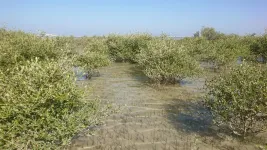
ELSE PRESS RELEASES FROM THIS DATE:
2021-01-05
ALBUQUERQUE, N.M. -- If everything moved 40,000 times faster, you could eat a fresh tomato three minutes after planting a seed. You could fly from New York to L.A. in half a second. And you'd have waited in line at airport security for that flight for 30 milliseconds.
Thanks to machine learning, designing materials for new, advanced technologies could accelerate that much.
A research team at Sandia National Laboratories has successfully used machine learning -- computer algorithms that improve themselves by learning patterns in data -- to complete cumbersome materials science calculations more than 40,000 times faster than normal.
Their results, published Jan. 4 in END ...
2021-01-05
Australian research has identified a new mechanism in which prostate cancer cells can 'switch' character and become resistant to therapy.
These findings, just published in Cell Reports, are an important development in unravelling how an aggressive subtype of prostate cancer, neuroendocrine prostate cancer (NEPC), develops after hormonal therapies.
It is well established that some tumours show increased cellular 'plasticity' in response to new or stressful conditions, such as cancer therapy, says lead researcher Associate Professor Luke Selth, from the Flinders ...
2021-01-05
What The Study Did: Data from public health surveillance of reported COVID-19 cases and seroprevalence surveys were used in this observational study that reports an estimated 46.9 million SARS-CoV-2 infections, 28.1 million symptomatic infections, 956,174 hospitalizations and 304,915 deaths occurred in the U.S. through November 15, 2020.
Authors: Frederick J. Angulo, D.V.M., Ph.D., of Medical Development and Scientific/Clinical Affairs of Pfizer Vaccines, is the corresponding author.
To access the embargoed study: Visit our For The Media website at this link https://media.jamanetwork.com/
(doi:10.1001/jamanetworkopen.2020.33706)
Editor's ...
2021-01-05
A new study led by researchers at the Universities of Bristol, Exeter, and Bath helps to shed light on the winter weather we may soon have in store following a dramatic meteorological event currently unfolding high above the North Pole.
Weather forecasting models are predicting with increasing confidence that a sudden stratospheric warming (SSW) event will take place today, 5 January 2021.
The stratosphere is the layer of the atmosphere from around 10-50km above the earth's surface. SSW events are some of the most extreme of atmospheric phenomena and can see polar stratospheric temperature increase by up to 50°C over the course of a few days. Such events ...
2021-01-05
By André Julião | Agência FAPESP - The black lion tamarin (Leontopithecus chrysopygus) once inhabited most forest areas in the state of São Paulo, Southeast Brazil, but currently occupies only some Atlantic Rainforest remnants there. In recent years, after various studies of the endangered species, environmental NGO Instituto de Pesquisas Ecológicas (IPÊ) moved groups of these animals to areas from which the species had disappeared.
Similar initiatives have now been reinforced by a group of researchers at IPÊ, São Paulo State University (UNESP) and the Federal University of Mato Grosso (UFMT), who cross-tabulated climate data and data on landscape (forest cover) to determine the sites best suited for future ...
2021-01-05
The asteroid impact 66 million years ago that ushered in a mass extinction and ended the dinosaurs also killed off many of the plants that they relied on for food. Fossil leaf assemblages from Patagonia, Argentina, suggest that vegetation in South America suffered great losses but rebounded quickly, according to an international team of researchers.
"Every mass extinction event is like a reset button, and what happens after that reset depends on which organisms survive and how they shape the biosphere," said Elena Stiles, a doctoral student at the University of Washington who completed the research as part of her master's thesis at Penn State. "All the biodiversity ...
2021-01-05
PROVIDENCE, R.I. [Brown University] -- Last month, Japan's Hayabusa2 mission brought home a cache of rocks collected from a near-Earth asteroid called Ryugu. While analysis of those returned samples is just getting underway, researchers are using data from the spacecraft's other instruments to reveal new details about the asteroid's past.
In a study published in Nature Astronomy, researchers offer an explanation for why Ryugu isn't quite as rich in water-bearing minerals as some other asteroids. The study suggests that the ancient parent body from which Ryugu was formed had likely dried out in some kind of heating event before Ryugu came into being, which left Ryugu itself drier than expected.
"One of the ...
2021-01-05
Repeated intravenous (IV) ketamine infusions significantly reduce symptom severity in individuals with chronic post-traumatic stress disorder (PTSD) and the improvement is rapid and maintained for several weeks afterwards, according to a study conducted by researchers from the Icahn School of Medicine at Mount Sinai. The study, published September XX in the American Journal of Psychiatry, is the first randomized, controlled trial of repeated ketamine administration for chronic PTSD and suggests this may be a promising treatment for PTSD patients.
"Our findings provide insight into the treatment efficacy of repeated ketamine ...
2021-01-05
As the world grows increasingly globalized, one of the ways that countries have come to rely on one another is through a more intricate and interconnected food supply chain. Food produced in one country is often consumed in another country -- with technological advances allowing food to be shipped between countries that are increasingly distant from one another.
This interconnectedness has its benefits. For instance, if the United States imports food from multiple countries and one of those countries abruptly stops exporting food to the United States, there are still other countries that can be relied on ...
2021-01-05
SAN ANTONIO and CHICAGO - An article published Jan. 5 in Alzheimer's & Dementia: The Journal of the Alzheimer's Association cites decades of published scientific evidence to make a compelling case for SARS-CoV-2's expected long-term effects on the brain and nervous system.
Dementia researchers from The University of Texas Health Science Center at San Antonio (UT Health San Antonio) are the first and senior authors of the report and are joined by coauthors from the Alzheimer's Association and Nottingham and Leicester universities in England.
"Since the flu pandemic of 1917 and 1918, many of the flulike diseases have been associated with brain disorders," said lead author ...
LAST 30 PRESS RELEASES:
[Press-News.org] Climate change caused mangrove collapse in Oman
Study points to sudden decrease of precipitation as cause


